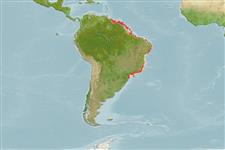Environment: milieu / climate zone / depth range / distribution range
Écologie
marin; eau douce; saumâtre; anadrome (Ref. 26213); profondeur 1 - 50 m (Ref. 189). Tropical; 9°N - 27°S, 61°W - 33°W (Ref. 189)
Western Atlantic: Orinoco delta in Venezuela south to Ponta da Cotinga, Paraná coast of Brazil.
Length at first maturity / Taille / Poids / Âge
Maturity: Lm 9.4, range 7 - ? cm
Max length : 18.0 cm TL mâle / non sexé; (Ref. 102462); common length : 9.0 cm TL mâle / non sexé; (Ref. 5217); poids max. publié: 32.00 g (Ref. 118626)
Épines dorsales (Total) : 0; Rayons mous dorsaux (Total) : 14 - 17; Épines anales: 0; Rayons mous anaux: 19 - 26. Body moderately elongate and compressed (Ref. 189). Snout short, about 2/3 eye diameter; maxilla relatively long, tip bluntly rounded, reaching to pre-operculum; gill cover canals of walkeri-type (Ref. 189). Anal fin fairly long, its origin below about middle of dorsal fin base. A broad silver stripe along flank, equal or greater than eye diameter below dorsal fin (Ref. 189).
A schooling species found inshore. Most likely anadromous, entering estuaries and freshwater. Feeds on crustacean larvae or small invertebrates (Ref. 12225). Female maximum length from Ref. 71685.
Both sexes at maturity have a large amount of visceral and intermuscular fat (Ref. 189). Spawn in school (Ref. 205).
Whitehead, P.J.P., G.J. Nelson and T. Wongratana, 1988. FAO Species Catalogue. Vol. 7. Clupeoid fishes of the world (Suborder Clupeoidei). An annotated and illustrated catalogue of the herrings, sardines, pilchards, sprats, shads, anchovies and wolf-herrings. FAO Fish. Synop. 125(7/2):305-579. Rome: FAO. (Ref. 189)
Statut dans la liste rouge de l'IUCN (Ref. 130435: Version 2024-2)
Menace pour l'homme
Harmless
Utilisations par l'homme
Pêcheries: intérêt commercial mineur
Outils
Articles particuliers
Télécharger en XML
Sources Internet
Estimates based on models
Preferred temperature (Ref.
123201): 24.5 - 27.8, mean 27.2 °C (based on 68 cells).
Phylogenetic diversity index (Ref.
82804): PD
50 = 0.5000 [Uniqueness, from 0.5 = low to 2.0 = high].
Bayesian length-weight: a=0.00537 (0.00470 - 0.00614), b=3.13 (3.09 - 3.17), in cm total length, based on LWR estimates for this species (Ref.
93245).
Niveau trophique (Ref.
69278): 3.1 ±0.30 se; based on food items.
Résilience (Ref.
120179): Haut, temps minimum de doublement de population inférieur à 15 mois (Fec=20,202).
Fishing Vulnerability (Ref.
59153): Low vulnerability (10 of 100).
Nutrients (Ref.
124155): Calcium = 273 [153, 637] mg/100g; Iron = 1.9 [1.1, 3.4] mg/100g; Protein = 18.3 [16.9, 19.7] %; Omega3 = 0.306 [0.154, 0.612] g/100g; Selenium = 41.1 [18.3, 94.0] μg/100g; VitaminA = 27.4 [8.1, 73.8] μg/100g; Zinc = 2.03 [1.39, 3.01] mg/100g (wet weight);
